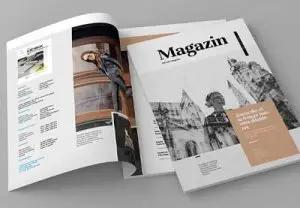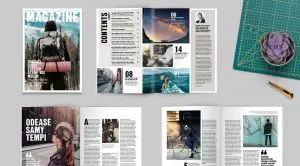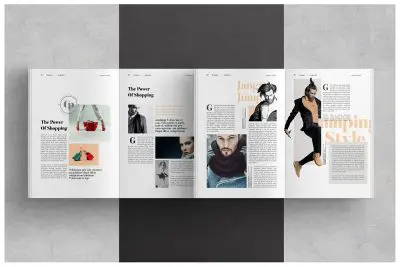Magazine size dimensions play a pivotal role in the world of publishing, design, and print media. These dimensions, often a key consideration for anyone involved in creating or selecting materials for magazines, encompass a range of factors that collectively define the physical characteristics of a magazine.
Understanding magazine size dimensions is essential for designers, publishers, and marketers alike, as it directly impacts the visual appeal, readability, and overall user experience of this widely consumed medium.
In this article, we’ll delve into the intricacies of magazine size dimensions, examining their significance and the various factors that influence the choices made in this critical aspect of magazine production.
What are standard magazine size dimensions?

Standard magazine size dimensions can vary depending on the country and publication. However, I can provide you with some common size options for magazines in the United States, which should give you a general idea. Magazine sizes are typically specified in terms of width and height, with the width being the dimension along the spine.
- Digest Size (5.5 x 8.5 inches): This is a smaller-sized magazine often used for pocket-sized publications, such as Reader’s Digest. It’s compact and easy to carry.
- Standard Size (8.375 x 10.875 inches): This is one of the most common magazine sizes in the U.S. It offers a good balance between readability and portability.
- Large Size (9 x 10.875 inches or 9 x 11 inches): Larger magazines are often used for publications that want to stand out or have more space for content and visuals.
- Tabloid Size (11 x 17 inches): Tabloid-sized magazines are quite large and are often used for publications with a heavy emphasis on visuals, such as photo magazines or art publications.
- Custom Sizes: Magazines can also come in various custom sizes to suit the publisher’s preferences or specific design requirements.
It’s important to note that magazine sizes can vary outside of the United States, and there may be different standard sizes in other countries. Additionally, magazines can also have variations in paper quality, binding methods, and page counts, all of which can affect the overall feel and appearance of the publication.
If you plan to create a magazine, it’s advisable to consult with a printing company to determine the specific dimensions and printing options available to you based on your design and content needs.
How do magazine dimensions vary by type (e.g., tabloid, broadsheet)?
Magazines come in various dimensions, and their sizes can vary depending on the type of publication and its target audience. Here are some common magazine dimensions based on different types:
- Standard Magazine: Standard magazines typically have dimensions around 8.5 x 11 inches (21.6 x 27.9 cm). This size is common for many consumer and niche magazines.
- Digest Magazine: Digest-sized magazines are smaller and more compact, with dimensions around 5.5 x 8.5 inches (13.9 x 21.6 cm). They are often used for pocket-sized publications or those with limited content.
- Tabloid Magazine: Tabloid-sized magazines are larger, with dimensions typically around 11 x 17 inches (27.9 x 43.2 cm). They are often used for publications with a focus on images, such as celebrity or gossip magazines.
- Broadsheet Magazine: Broadsheet-sized magazines are even larger, with dimensions around 11 x 17 inches (27.9 x 43.2 cm) or larger. They are similar in size to traditional newspapers and are often used for publications with in-depth reporting and long-form articles.
- Square Magazine: Square-shaped magazines have dimensions that are the same for both width and height, such as 8 x 8 inches (20.3 x 20.3 cm) or 10 x 10 inches (25.4 x 25.4 cm). This format is popular for art and photography magazines.
- Oversized Magazine: Oversized magazines can have dimensions significantly larger than standard magazines, with widths of 9 inches (22.9 cm) or more and varying heights. They are often used for special editions, art publications, or coffee table magazines.
- Mini Magazine: Mini magazines are smaller than standard magazines, with dimensions ranging from 4 x 6 inches (10.2 x 15.2 cm) to 5 x 7 inches (12.7 x 17.8 cm). They are often used for promotional materials or as supplements to larger publications.
It’s important to note that these dimensions can vary slightly between publishers and regions. The choice of magazine size often depends on the content, target audience, and intended use of the publication. Additionally, some magazines may have custom or unique dimensions to stand out in the market.
What are common size dimensions for fashion magazines?
The most common size dimensions for fashion magazines are:
- Letter size: 8.5 x 11 inches (22 x 28 cm)
- Digest size: 5.5 x 8.5 inches (14 x 22 cm)
- Square size: 8.5 x 8.5 inches (22 x 22 cm) or 5.5 x 5.5 inches (14 x 14 cm)
The letter size is the most common size for all types of magazines, including fashion magazines. It is a large size that allows for plenty of space for images and text. The digest size is slightly smaller than the letter size and is often used for magazines that focus on shorter articles and features. The square size is a unique format that is becoming increasingly popular for fashion magazines. It is eye-catching on shelves and offers a different reading experience for readers.
Of course, there are other sizes of fashion magazines as well. Some magazines are even larger than the letter size, while others are smaller than the digest size. The specific size of a fashion magazine will depend on the publisher’s preferences and the target audience.
How do dimensions affect layout and design?
The dimensions of a publication, including magazines, play a significant role in determining the layout and design. The size and shape of a magazine affect several aspects of its design and user experience:
- Content Organization: Magazine dimensions influence how content is organized. Larger formats can accommodate more content on each page, allowing for more elaborate layouts, larger images, and longer articles. Smaller formats may require more concise content and simplified layouts.
- Typography: Magazine size affects font size choices. In larger magazines, you might use larger fonts for readability, while smaller magazines may require smaller fonts to fit content on the page. Typography also varies based on the publication’s tone and target audience.
- Image Placement: Larger magazines offer more space for images, allowing for more dramatic and visually appealing layouts. Smaller magazines may need to use smaller images or more selective placement to fit within the layout.
- Whitespace: The amount of whitespace, or empty space on a page, is influenced by the magazine’s size. Smaller magazines may have less whitespace to maximize content, while larger magazines can use more whitespace for a cleaner, more open design.
- Grid Systems: The grid system used for layout design is tailored to the magazine’s dimensions. A larger magazine may have a more complex grid with multiple columns, while a smaller one might have a simpler grid to maintain readability.
- Page Count: The dimensions can affect the number of pages required to accommodate content. Smaller dimensions may result in more pages, which could impact printing costs.
- User Experience: The physical size of the magazine affects how readers interact with it. Larger formats might be more visually engaging but less portable, while smaller formats are more convenient for reading on the go.
- Binding and Foldout Sections: Magazine dimensions also impact the binding method and the possibility of including foldout sections, which can be used for large illustrations, maps, or infographics.
- Advertising: Advertisers often have specific requirements for ad sizes based on the magazine’s dimensions, which can influence the overall design and layout.
- Cost Considerations: Printing costs can vary based on the magazine’s size. Larger formats often require more paper and ink, which can increase production costs.
Advantages of larger magazine dimensions

Larger magazine dimensions offer several advantages, but it’s essential to consider these benefits in the context of your specific publication goals and target audience. Here are some advantages of larger magazine dimensions:
- Visual Impact: Larger magazines have more space for visually striking layouts, high-quality images, and captivating design elements. This can make the publication more visually appealing and engaging for readers.
- Enhanced Readability: Larger dimensions allow for larger text and more comfortable reading. This is especially beneficial for publications with lengthy articles or content intended for older readers who may have difficulty with small fonts.
- Layout Creativity: Designers have greater flexibility to experiment with creative and complex page layouts, making the publication stand out and enabling innovative storytelling techniques.
- Increased Space for Content: You can include more content per page or add additional content elements like sidebars, pull quotes, and infographics without making the layout feel cluttered.
- Premium Look and Feel: Larger magazines can convey a sense of luxury and sophistication, which may align well with certain target audiences or brands.
- Showcasing Photography and Art: If your magazine focuses on photography, art, or visual storytelling, larger dimensions allow for larger and more impactful image presentations.
- Prominent Advertising: Advertisers may find larger formats more attractive for showcasing their products or services, potentially leading to higher ad revenue.
- Branding Opportunities: A larger canvas provides more space for branding elements, helping to reinforce your publication’s identity and message.
- Foldout Sections: Larger magazines can accommodate foldout sections, which can be used for stunning visual displays, maps, or infographics. These can be attention-grabbing and add value to the publication.
- Easier Handling of Complex Content: If your magazine deals with complex subject matter or in-depth articles, larger dimensions can make it easier to present and navigate through this content.
- Limited Competition: Depending on your niche, a larger magazine size might differentiate you from competitors who opt for standard or smaller formats.
However, it’s important to note that larger magazine dimensions also have some downsides, including increased printing and distribution costs, reduced portability, and potentially higher reader expectations for content quality and visual appeal.
You should carefully consider your target audience, content type, and budget when deciding on the magazine’s size to ensure it aligns with your publication’s goals and resources.
How do dimensions impact printing and distribution?
The dimensions of a magazine have a significant impact on both printing and distribution processes. Here’s how magazine dimensions affect these aspects:
Printing:
- Paper Costs: The physical size of the magazine affects the amount of paper required for each copy. Larger dimensions typically require more paper, which can increase printing costs.
- Printing Equipment: Printing presses are often configured to handle specific paper sizes and formats. Printing a magazine with non-standard dimensions may require custom setups, which can be more expensive.
- Ink Usage: Larger magazines may require more ink, especially if they contain larger images or more extensive use of color. This can increase both printing costs and drying times.
- Setup and Plate Costs: Printing presses need to be set up for each print run, and larger dimensions may involve more complex setups and larger printing plates, leading to higher setup costs.
- Quality Control: Larger magazines may be more susceptible to printing defects, such as misalignment or ink smudging, which can affect overall print quality and require additional quality control measures.
Distribution:
- Shipping Costs: Larger magazines are heavier and bulkier, which can result in higher shipping costs, especially if they need to be transported over long distances.
- Storage Space: Larger magazines require more storage space both at the printing facility and distribution centers. This can impact logistics and storage costs.
- Retail Display: Retailers may have limited space for displaying magazines. Larger magazines might require more prominent shelf space, which could be a challenge for distribution.
- Reader Convenience: Larger magazines may be less convenient for readers to carry and store, potentially affecting their willingness to purchase or subscribe.
- Distribution Networks: Some distribution networks and methods may have limitations on the size of magazines they can handle. For example, if you plan to distribute through postal services, check their size and weight restrictions.
- Packaging: Larger magazines may require custom packaging or protection during distribution to prevent damage, which can add to packaging costs.
- Distribution Time: Larger magazines may take longer to print and distribute due to the increased production and handling requirements.
It’s crucial to carefully consider these factors when determining the dimensions of your magazine. Balancing the advantages of a larger format, such as visual impact and content space, with the associated printing and distribution costs is essential for a successful publication.
Additionally, discussing your requirements with your printing and distribution partners can help you make informed decisions based on your budget and target audience.
Differences in dimensions for international vs. domestic publications
International and domestic publications can differ in several dimensions, including content, format, distribution, and audience. Here are some key differences:
- Content and Language:
-
- Language: International publications often use a language that is widely understood, such as English, to reach a global audience. Domestic publications primarily use the language of their home country.
- Content Focus: International publications may cover a broader range of topics and have more international news, while domestic publications focus primarily on local or national news and issues.
- Audience:
-
- Global vs. Local: International publications target a global or diverse audience, whereas domestic publications cater to a local or national readership.
- Cultural Sensitivity: International publications may need to be more culturally sensitive and aware to appeal to a diverse readership.
- Format and Design:
-
- Layout: International publications may have a standardized layout and design to appeal to readers from different cultures. Domestic publications might have more flexibility in design.
- Units of Measurement: International publications often use metric units alongside imperial units to accommodate a global audience.
- Distribution and Accessibility:
-
- Distribution Channels: International publications may rely more on digital distribution, making them accessible worldwide. Domestic publications may have a stronger emphasis on print distribution or local digital platforms.
- Availability: International publications may be available in multiple countries through various channels, whereas domestic publications are primarily accessible within their home country.
- Editorial Standards:
-
- Fact-Checking: International publications often have stricter fact-checking and editorial standards to maintain credibility across borders. Domestic publications may focus on issues specific to their region and may have different editorial priorities.
- Advertising and Revenue Sources:
-
- Advertisers: International publications may attract global advertisers seeking a broad audience, while domestic publications rely more on local businesses for advertising revenue.
- Subscription Models: Domestic publications may rely more on subscription models for revenue, while international publications may offer more content for free to attract a larger global audience and generate revenue through ads or premium subscriptions.
- Censorship and Regulation:
-
- Regulatory Differences: International publications may need to navigate various regulations and censorship issues in different countries, affecting the content they can publish. Domestic publications primarily deal with their home country’s regulations.
- Time Zones and Publication Schedule:
-
- Publication Timing: International publications may adjust their publication schedules to accommodate different time zones, whereas domestic publications follow a local schedule.
- Cultural Sensitivity:
-
- Cultural References: International publications may need to explain cultural references or use more universal symbols to ensure readers from various backgrounds can understand the content.
- Global vs. Local Perspective:
-
- Editorial Perspective: International publications often adopt a more global perspective, while domestic publications focus on local or national issues and perspectives.
It’s important to note that these differences can vary depending on the specific publication, its target audience, and its editorial mission. Some international publications may have a strong regional focus, and some domestic publications may have an international audience if they cover niche topics of global interest.
Factors when choosing dimensions for a target audience

Choosing the right dimensions for a target audience involves considering a variety of factors to ensure your content, product, or message effectively resonates with the intended group. Here are key factors to consider:
- Demographics:
-
- Age: Consider the age range of your audience. Content or products designed for teenagers will differ significantly from those for senior citizens.
- Gender: Some products or messages may be gender-specific or need to consider gender preferences.
- Income: Understanding the income level of your audience helps determine pricing and affordability.
- Education: Tailor your message and content complexity based on the educational background of your target audience.
- Occupation: The professions or jobs of your audience can influence their interests and needs.
- Geographic Location:
-
- Consider whether your audience is local, regional, national, or international. Geographic factors can influence language, cultural norms, and local preferences.
- Psychographics:
-
- Values and Beliefs: Understand the values and belief systems of your audience to align your content or product with their worldview.
- Lifestyle: Consider the lifestyle choices, hobbies, and interests of your audience to tailor your offerings.
- Personality Traits: Certain products or content may appeal more to specific personality types.
- Behavioral Patterns:
-
- Purchasing Behavior: Analyze how your target audience shops and makes buying decisions.
- Online Behavior: Understand their digital habits, including which platforms they use and how they consume online content.
- Interactions: Consider how your audience interacts with brands, products, or content.
- Needs and Pain Points:
-
- Identify the problems or challenges your audience faces and how your content or product can provide solutions.
- Prioritize the most pressing needs to ensure your offering addresses them effectively.
- Communication Preferences:
-
- Determine how your audience prefers to receive information: via email, social media, websites, print, video, etc.
- Adapt your messaging and content format to align with these preferences.
- Cultural Sensitivity:
-
- Recognize cultural differences that may impact how your message is received and interpreted.
- Avoid cultural insensitivity or offensive content that could alienate your audience.
- Technological Proficiency:
-
- Assess the tech-savviness of your audience. Some groups may prefer traditional media, while others are highly digitally engaged.
- Competitive Landscape:
-
- Analyze the competitors targeting the same audience and identify gaps or opportunities to differentiate your offering.
- Budget and Resources:
-
- Consider the resources available to tailor your offerings. Some dimensions may require more extensive customization, which may not be feasible with limited resources.
- Feedback and Research:
-
- Collect feedback from your target audience through surveys, focus groups, or online interactions to refine your approach.
- Conduct market research to gain insights into changing preferences and trends.
- Legal and Ethical Considerations:
-
- Ensure your offerings comply with relevant laws and ethical guidelines specific to your target audience and industry.
- Scalability:
-
- Consider whether your chosen dimensions allow for scalability, especially if you plan to expand your reach in the future.
- Testing and Iteration:
-
- Be prepared to test different dimensions and make adjustments based on real-world feedback and performance metrics.
- Long-Term Sustainability:
-
- Think about whether the dimensions you choose will remain relevant and effective in the long term or if you need to adapt to changing audience dynamics.
Remember that audience dimensions may overlap or evolve over time, so it’s essential to continuously monitor and adapt your approach to meet the evolving needs and preferences of your target audience.
Recommended:
Conclusion
If you need to know more about magazine size dimensions, then you are secured. Choosing the right magazine size dimensions is a crucial decision that impacts the overall look, feel, and readability of the publication.
It influences factors like content layout, printing costs, and reader experience. Consideration of audience preferences, content type, and distribution method is essential in making this decision. Ultimately, the chosen size should align with the publication’s goals and enhance its visual appeal for the target audience.


